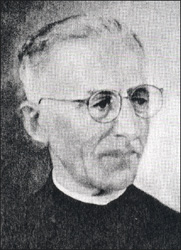Jean-Baptiste Janssens General # 27
General from 1946 to 1964
 |
He was born in Mechelen, Belgium three days before Christmas on December 22, 1889. His first schooling was in the Diocesan Secondary School in Hasselt and his university years, where he excelled in Philosophy and Classical Philology, were spent at St. Aloysius University Faculty in Brussels. He entered the Jesuit Novitiate in Drongen on September 23, 1907, and took his first Vows in September 1909.
After the usual two years of Philosophy spent at the Jesuit Collegium Maximum in Leuven he won his Doctorate in Civil Law at the University of Louvain (Leuven).
From 1921 to 1923 he attended the Gregorian University in Rome where he added a Doctorate in Canon Law to the one he had earned at Louvain.
He taught Canon Law at the Collegium Maximum in Louvain from 1923 until 1929 and became its Rector on August 17, 1929. On August 15, 1935 he was appointed Tertian Master and in 1938 became Provincial of the Northern Belgian Province of the Jesuits.
During the year 1939 in the name of the General he made an official visit to the Jesuit missions in Zaire, at the time a protectorate of Belgium and known as the Belgian Congo. With the exception of this visitation and his two years studying in Rome, he had spent most of his life in his own province—in Leuven, Drongen, Antwerp, and Brussels.
When Father Ledochowski died in 1942 the war was in full fury in Europe and Father Janssens was the Jesuit Provincial trying to keep his province intact and in peace. The Vicar General, Norbert de Boyne was unable to call a General Congregation because of the war. Thus, in effect, de Boyne was in charge of the governance of the Society for three years.
The war ended in August 1945 and de Boyne was finally able to convene a General Congregation—the 29th—between September 6 and October 23, 1946. Janssens, as Provincial of his province, went to Rome as a delegate. The Congregation was held under Spartan conditions and many of the necessaries were provided by the delegates themselves from countries less affected by the war than were the countries of Europe.
On September 15, Father Janssens the 57-year old Belgian was elected General on the first ballot and became the first General in the Nuclear Age.
Because of his delicate health and the oppressiveness of the Roman air, a sizeable piece of property in the Alban Hills—southeast of Rome —was purchased as a retreat for the general and his curia. This property, well known in the area as Villa Cavalletti, became a place of retreat not only for the General and the Curia but also for the other Jesuits of Rome. It was also used and appreciated by professors and students of the Gregorian University—who could manage to get away for a few days of peace. It was finally sold in 1995, long after Father Janssens was in his grave.
In 1957 after eleven years in office he summoned the 30th General Congregation to provide him with a Vicar General. During its September 6 to November 11 session the delegates appointed Father John Swain, a Canadian, as his Vicar.
In his final years Janssens had to confront a dissension which was arising among theologians inside and outside the Society. He tried to moderate the problem, but to no avail, since the difficulty was not only within the Society, but also throughout the whole Church. He was the last to see the numbers in the Society top out at 36,000 members. After which high point there was a steady drop for the next thirty years. The turmoil in the Society and in the Church would not go away.
Pope John XXIII had convened Vatican Council II to begin in 1962 to deal with many of the same problems that plagued Janssens during his generalate, and with which he found it difficult to cope.
After 18 years and one month as General, Father Janssens died at the age of 75 on October 5, 1964. His body was taken to the Jesuit mausoleum at Campo Verano and interred with his immediate predecessors.